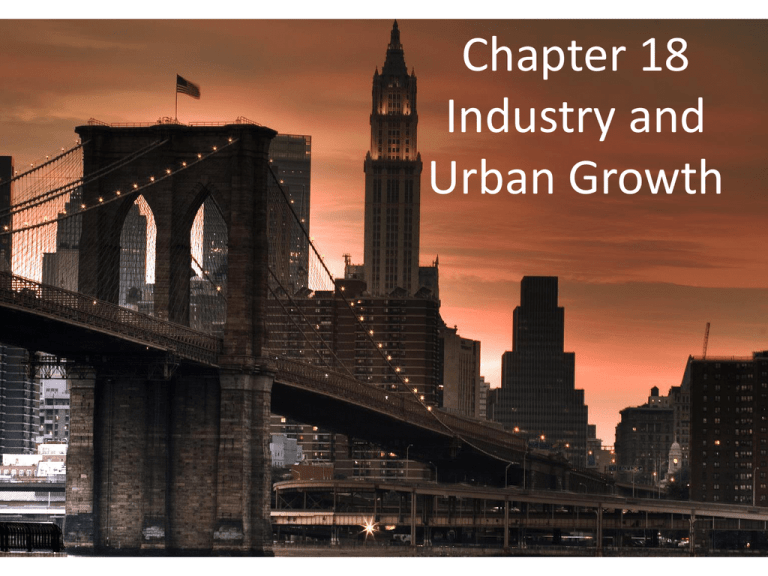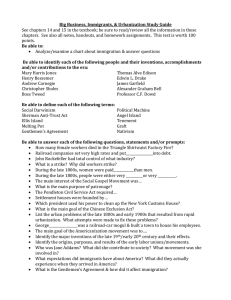Industry and Urban Growth - Saugerties Central School
advertisement

Chapter 18 Industry and Urban Growth Industry Boom • the nation expanded west and found deposits of coal, iron, and copper, • Government created policies that favored industrial growth – Including tariffs – Tax on imports Steel and Oil • Building blocks of modern United States Inventions • In the late 1800s Americans started to create many new inventions – In 1897 the government issued more patents than in the ten years before the Civil War • America became known as the land of Invention Inventions • Thomas Edison- invented the light bulb, phonograph, motion picture camera, and hundreds of other devices • In 1882, Edison opened the nation’s first electrical power plant in New York City – Helped to bring in the age of electricity Inventions • Communications – In 1876 Alexander Graham Bell built a device that carried the human voice (telephone) • By 1885 more than 300,00 phones had been sold – Succeeded in 1876 when he sent the first telephone message to his assistant “Mr. Watson, come here. I want you.” Inventions • Other inventions include the type writer, shoe making machine, light weight camera, flash for the camera Inventions • In 1900 only 8,000 Americans owned automobiles • Henry Ford perfected a system that made the automobile available to millions, known as the assembly line – By 1917 more than 4.5 million Americans owned cars Inventions • In 1903 Wilbur and Orville Wright were the first people ever to fly – The first flight lasted 12 seconds and flew 120 feet New Ways of Doing Business • Business expansion was led by bold entrepreneurs • Businesses became corporations – Corporations limited the risk of investors New Ways of Doing Business • Banks lent huge amounts of money to corporations, which led to industries growing faster Growth of Big Business • Government had a laissez-faire approach to business in the late 1800s • They allowed for the rapid growth of big business and for the creation of monopolies Growth of Big Business • Andrew Carnegie – Managed to gain control of the steel industry – Believed that the rich had a duty to improve society (Gospel of Wealth) Growth of Big Business • John D. Rockefeller – Started an oil refinery at the age of 23 – Used his profits to buy other oil companies and managed to take control of the oil industry Working Conditions • Industries attracted millions of new workers • Most were immigrants or native born whites Working Conditions • Women worked and outnumbered men in some industries, such as textile mills, tobacco factories, and the garment sweatshops of New York • Children worked in bottle factories, textile mills, tobacco factories, coal mines, and sweatshops – Most child laborers could not go to school, and had little chance of improving their lives Working Conditions • New York City, March 25, 1911 fire broke out in the Triangle Shirtwaist Factory. – Hundreds of workers raced to the exits only to find the exits were locked – Nearly 150 people died as a result of the fire Working Conditions • Factory work was dangerous – Workers would breathe in fibers or dust while working at textile mills or mines and would come down with lung diseases – Steelworkers risked death and burns from the molten metal • Social Darwinists believed that harsh conditions were necessary to cut costs, increase production, and ensure survival of the business Lewis Hine • was an American sociologist and photographer. Hine used his camera as a tool for social reform. His photographs were instrumental in changing the child labor laws in the United States Workers Organize • Workers attempted to form unions in order to secure safer working conditions, higher wages, and shorter hours Workers Organize • Knights of Labor-1869 – One of the earliest and most powerful unions in the United States – Success were undercut by a series of violent labor disputes • Haymarket Square (May 4, 1886) Workers Organize • 1886 Samuel Gompers formed a new union called the American Federation of Labor (AFL) – By 1904 the AFL had over one million members Workers Organize • The AFL believed in using collective bargaining and strikes but only if all else failed • AFL only allowed skilled workers and banned African Americans, immigrants, and unskilled workers Workers Organize • Bitter Strikes – In 1893 the nation was hit by a severe economic depression • Businesses cut production, fired workers, and cut wages Workers Organize • Pullman Strike – Workers’ pay was cut by 25% • Angry workers walked out – Railroad workers also walked out in support – Rail lines were shut down from coast to coast – President Grover Cleveland sent in federal troops to end the strike Workers Organize • Army fired into the crowds killing two protesters • Most Americans sided with owners when workers would strike Rapid Growth of Cities • New technology helped cities grow – Elevated trains, electric streetcar, subways • Public transportation allowed for the creation of the suburbs (people no longer had to live in the city in order to work in the city) – Creation of steel bridges (Brooklyn Bridge) helped to create suburbs Rapid Growth of Cities • Cities also began to expand upward with skyscrapers Problems of Urban Life • People lived in crowded tenements – Buildings had no windows, heat, or indoor plumbing – 10 people might live in a single room – Street were littered with garbage • Outbreaks of diseases were common • in one Chicago tenement half of all babies died before age of one • Jacob Riis helped to bring attention to the horrible living conditions and wrote a book entitled How the Other Half Lives Problems of Urban Life • In 1880s cities began to improve urban life – Installed streetlights, set up fire, sanitation, and police departments • social reformers worked to help the poor – Jane Addams, opened a settlement house in the slums of Chicago The New Colossus Not like the brazen giant of Greek fame, With conquering limbs astride from land to land; Here at our sea-washed, sunset gates shall stand A mighty woman with a torch, whose flame Is the imprisoned lightning, and her name Mother of Exiles. From her beacon-hand Glows world-wide welcome; her mild eyes command The air-bridged harbor that twin cities frame. "Keep ancient lands, your storied pomp!" cries she With silent lips. "Give me your tired, your poor, Your huddled masses yearning to breathe free, The wretched refuse of your teeming shore. Send these, the homeless, tempest-tost to me, I lift my lamp beside the golden door!" The New Immigrants • Between 1865 and 1915 about 25 million immigrants entered the United States – (that is more than the population of the entire country in 1850) The New Immigrants Why were there so many immigrants coming to the United States? The New Immigrants • countries were becoming over populated • immigrants wanted religious freedom • were trying to escape political persecution The New Immigrants Why the United States? The New Immigrants • The U.S. was seen as a land of opportunity where they could build a better life – U.S. had jobs, promise of freedom, a tradition of democracy and liberty The New Immigrants • In early 1800s most immigrants were Protestant and from northern and western Europe (most spoke English) • In the late 1800s “new immigrants” began to arrive from Italy, Poland Russia, and Greece – Most were Catholic or Jewish and most did not speak English The New Immigrants • Coming to America – Immigrants came by boat and were crammed below decks in steerage – Most people coming from Europe landed in New York and after 1892 went through Ellis Island The New Immigrants • About 2/3 of immigrants settled in cities and near people from the same country The New Immigrants • New immigrants worked hard to assimilate – It was easier for children to assimilate • Goal of many immigrants was to educate their children so they would be better off Nativism • Increased immigration led to a wave of nativism – People that sought to preserve the U.S. for nativeborn American citizens • Nativists argued that the new immigrants would not assimilate Educating Americans • Before 1870, fewer than half of American children went to school • United States realized the need for an educated workforce • States passed compulsory education laws Educating Americans • The School Day – Typical school day lasted from 8:00 a.m. to 4:00 p.m. – Pupils learned the three r’s “reading, ‘riting, and ‘rithmetic Educating Americans • As more Americans began to read, more books and magazines became available – Most people read low-priced paperbacks that told about thrilling adventures (“Wild West” or “ragsto-riches”) New American Writers • Some writers were realists – Realists described the hardships of most immigrants living in the slums – Jack London • The Call of the Wild • White Fang • Kate Chopin – The Awakening • Mark Twain – Huckleberry Finn Newspaper Boom • The amount of newspapers in the united states grew very quickly in the late 1800s – The spread of education was one reason for the growth of the newspaper industry – The newspaper boom was linked to urbanization Newspaper Boom • Joseph Pulitzer created the first modern newspaper, New York World Newspaper Boom • Pulitzer added features to the newspaper, like The Yellow Kid Newspaper Boom • New York World became known for its sensational headlines that told of crime and scandal. – This style of writing became known as yellow journalism






